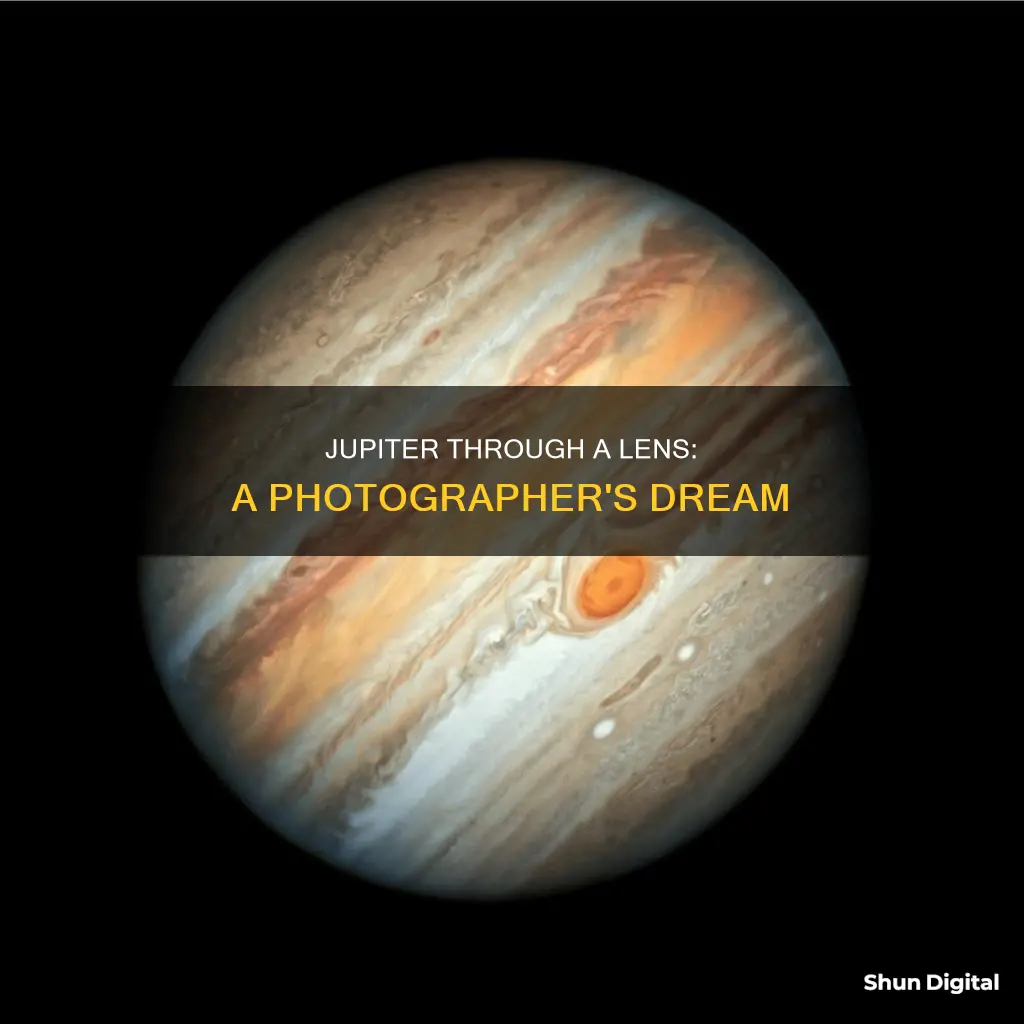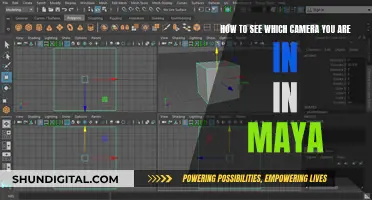
Jupiter is a fascinating planet to observe through a telescope. It is big, bright, and rotates rapidly. Its storms are constantly in motion while its four bright moons race around the planet. Jupiter's famous Great Red Spot is an anticyclonic storm measuring nearly 15,000 miles in diameter and is large enough to contain at least two Earths side by side. Its winds can reach over 270 miles per hour – faster than Earth's strongest hurricane wind speed ever recorded.
Capturing images of Jupiter can be challenging due to the extreme difference in brightness between the planet and its moons. The best method for doing planetary imaging is recording video through a telescope, then using software to align and combine the best frames into a static image. This process is called image stacking and can be done using programs like Registax.
When photographing Jupiter, it is important to use the right equipment and techniques. A telescope with an aperture of 60mm to 90mm can reveal Jupiter's four brightest moons and its cloud belts and zones. An 8x42 binocular or 9x50 finderscope will also easily reveal the four Galilean moons. For more detailed views, a larger telescope, such as a Maksutov-Cassegrain or Schmidt-Cassegrain telescope with an aperture of four inches or more, is recommended.
To reduce the brightness of Jupiter in photographs, it is crucial to use short exposure times, lower ISO settings, and small apertures. Color filters can also be used to enhance subtle features in Jupiter's atmosphere. Additionally, using a smartphone or DSLR camera with the appropriate adapters can help capture images of Jupiter and its moons.
What You'll Learn

Jupiter's Galilean moons: Io, Europa, Ganymede, and Callisto
Jupiter has more than 60 moons, but its four largest are known as the Galilean moons: Io, Europa, Ganymede, and Callisto. These moons are important in the history of science because their discovery disproved the theory that all objects in the cosmos orbited the Earth. They are the closest large moons to Earth and are easily visible through a small telescope.
Io, the innermost Galilean moon, is the third-largest of the four and the only rocky moon other than Earth's that is large enough to have taken a round shape. It is the most volcanically active body in the Solar System, with near-constant eruptions across its surface. Io's activity is generated by heat deep inside its centre. The force needed to keep Io in synchronous rotation with Jupiter creates bulges on Io, much like how Earth's oceans have tides because of the Moon. The constant change in size and orientation of Io causes friction, which creates enough internal heat for volcanic eruptions to occur.
Europa, the second Galilean moon, has the smoothest surface in the Solar System, with no large mountains, deep craters, or canyons. Its surface and crust are made almost entirely of water ice, and it may have a subsurface liquid layer. Data collected by NASA's Voyager and Galileo missions suggest that under about 30 kilometres of ice, Europa may be holding an ocean 70-100 kilometres deep. Even though Europa is smaller than Earth's moon, its oceans are thought to contain twice as much liquid water as all of Earth's oceans and lakes combined.
Ganymede, the third Galilean moon, is the largest moon in the Solar System, even bigger than the planet Mercury. It is the only moon in the Solar System known to have its own magnetic field. Like Europa, Ganymede has a thick outer layer of ice, but unlike its icy sister, Ganymede shows no signs of a freshly resurfaced exterior. It may have several ocean layers, stacked up with layers of ice in between them.
Callisto, the fourth and outermost Galilean moon, is the third-largest moon in the Solar System. Measurements of its density show that it is about half rock and half water ice. Callisto doesn't experience the kind of gravitational fluctuations that warm up the interiors of the other Galilean moons, so it doesn't have any tectonic activity or volcanism. It is thought to have the oldest surface in the Solar System and is so completely covered in craters that any new impactor would almost certainly hit an existing crater. Despite showing no signs of geological life, Callisto still shows some signs of having liquid water deep below its surface.
Unveiling TV News Camera Resolution Secrets
You may want to see also

Jupiter's Great Red Spot
The mystery surrounding the Great Red Spot is twofold: how it formed, and why it is so long-lived. One hypothesis is that it is trapped between two opposite-flowing jet streams, acting like conveyor belts that keep the storm spinning. Another hypothesis is that the vertical flow of heat and cold inside the storm helps keep it alive. The fact that Jupiter is a gas planet with no surface means there is no friction to slow the storm.
The Great Red Spot's reddish hue is also a mystery. It is not known what causes its colour, but hypotheses supported by laboratory experiments suppose that it may be caused by chemical products created from the solar ultraviolet irradiation of ammonium hydrosulfide and the organic compound acetylene, which produces reddish material. The spot's colour also varies over time, from brick-red to pale salmon or even white, and it occasionally disappears.
The Great Red Spot is not only shrinking but also changing shape, colour, and other characteristics. It is not known how long the spot will last, but research has suggested that it could disappear within one or two decades. However, other astronomers believe that the apparent size of the Great Red Spot reflects its cloud coverage and not the size of the actual, underlying vortex, and that the storm is not in danger of dissipating.
Smart TV Camera: A Hacker's Window to Your Home
You may want to see also

Jupiter's rings
The rings consist mainly of dust ejected from the moons Metis, Adrastea, and possibly smaller, unobserved bodies as a result of high-velocity impacts. The dust particles in the rings vary in size, with a cross-sectional area that is greatest for non-spherical particles of a radius of about 15 μm in all rings except the innermost "halo ring", which is dominated by sub-micrometre dust. The total mass of the ring system is estimated to be in the range of 10^11 to 10^16 kg.
The age of the ring system is unknown, but it may have existed since Jupiter's formation. The rings appear to have a reddish colour, except for the halo ring, which is neutral or blue. The Jovian ring system was the third to be discovered in the Solar System, after those of Saturn and Uranus.
Trail Camera's Bat Vision: What They See After Dark
You may want to see also

Jupiter's storms and winds
Jupiter's atmosphere is the largest in the Solar System, and it is mostly made up of molecular hydrogen and helium. The atmosphere lacks a clear lower boundary and gradually transitions into the liquid interior of the planet. The lowest layer, the troposphere, has a complex system of clouds and hazes composed of layers of ammonia, ammonium hydrosulfide, and water. The upper ammonia clouds visible at Jupiter's surface are organised into a dozen zonal bands parallel to the equator and are bounded by powerful zonal atmospheric flows (winds) known as jets. The bands alternate in colour: the dark bands are called belts, and the light ones are called zones. Zones, which are colder than belts, correspond to upwellings, while belts mark descending gas.
The Jovian atmosphere shows a wide range of active phenomena, including vortices (cyclones and anticyclones), storms, and lightning. The vortices reveal themselves as large red, white, or brown spots (ovals). The largest two spots are the Great Red Spot (GRS) and Oval BA, which is also red. These two and most of the other large spots are anticyclonic. Smaller anticyclones tend to be white. Vortices are thought to be relatively shallow structures with depths not exceeding several hundred kilometres. Located in the southern hemisphere, the GRS is the largest known vortex in the Solar System. It could engulf two or three Earths and has existed for at least 300 years. Oval BA, south of GRS, is a red spot a third of the size of GRS that formed in 2000 from the merging of three white ovals.
Jupiter has powerful storms, often accompanied by lightning strikes. The storms are a result of moist convection in the atmosphere connected to the evaporation and condensation of water. They are sites of strong upward motion of the air, which leads to the formation of bright and dense clouds. The storms form mainly in belt regions. The lightning strikes on Jupiter are hundreds of times more powerful than those seen on Earth and are assumed to be associated with the water clouds. Recent Juno observations suggest Jovian lightning strikes occur above the altitude of water clouds (3-7 bars). A charge separation between falling liquid ammonia-water droplets and water ice particles may generate higher-altitude lightning. Upper-atmospheric lightning has also been observed 260 km above the 1-bar level.
Hisense Smart TV Camera Location Explained
You may want to see also

Jupiter's magnetic field
Jupiter's magnetosphere is a complex structure with several components, including a bow shock, magnetosheath, magnetopause, magnetotail, and magnetodisk. It is driven primarily by the planet's rotation and shaped by Io's plasma and its own rotation, rather than by the solar wind as on Earth. The magnetosphere traps and accelerates particles, producing intense radiation belts similar to Earth's Van Allen belts but thousands of times stronger. These radiation belts pose significant hazards to spacecraft and potential human space travellers.
The interaction of Jupiter's magnetic field with its moon Io is particularly notable. Io is volcanically active, ejecting large amounts of sulfur dioxide gas into space and forming a large torus, or doughnut-shaped ring, of charged particles around Jupiter. The magnetic field forces the torus to rotate with the same angular velocity and direction as the planet. In turn, the torus loads the magnetic field with plasma, stretching it into a pancake-like structure called a magnetodisk. This greatly expands the size of Jupiter's magnetosphere.
Io's plasma torus is a significant source of charged particles in Jupiter's magnetosphere, providing as much as 1,000 kg of new material every second. The plasma temperature within the torus is much lower than that of the particles in the radiation belts—100,000–1,000,000 Kelvin compared to 100 million Kelvin. As the plasma moves away from Jupiter, its radial currents increase velocity, maintaining co-rotation with the planet.
Wyze Camera: Is Someone Spying on You?
You may want to see also
Frequently asked questions
A camera on Jupiter would see its moons, the planet's cloud bands, and the Great Red Spot.
The main challenge of taking pictures of Jupiter is the difference in brightness between the planet and its moons. Jupiter is very bright, and its moons are much dimmer. This makes it difficult to capture both in the same image without blowing out the details of the planet.
Additionally, atmospheric conditions, camera movement, and focusing errors can also affect the quality of the images.
To take pictures of Jupiter, you will need a camera with manual settings, a stable tripod, and preferably a telescope. A remote shutter release can also help reduce camera shake.







